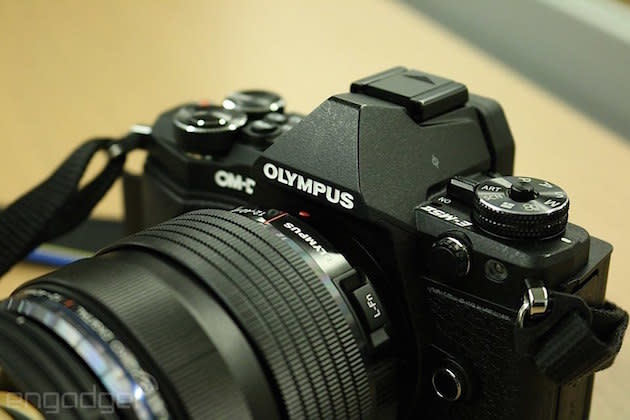Olympus' OM-D E-M5 Mark II is a solid mid-range mirrorless camera
Camera manufacturers do a great job of not making your purchases feel obsolete after a year. Case in point: Olympus' OM-D E-M5 Micro Four Thirds camera, which the company updated last month, more than three years after the original was introduced. I'm not saying the original is obsolete per se, but there's no doubt the new E-M5 Mark II is a godsend for people invested in the Olympus ecosystem. So what's actually new in this model, you ask? A lot, both inside and out, although it does maintain a similar look and feel to its predecessor.
Unsurprisingly, it was clear from the get-go Olympus wanted to focus on improving the camera's video attributes. As such, the second-gen E-M5 can shoot 1080p at 24, 25, 30, 50 and 60 fps, and can handle a 77 Mbps bit rate at 30 fps -- a notable upgrade from the recording specs found on the previous version. A 16-megapixel Live MOS sensor with a TruePic VII image chip powers this updated model, which also boasts an 81-point autofocus system and a redesigned 3-inch LCD that now tilts and swivels.
In addition, there's a 40-megapixel (64 in RAW), high-resolution shooting mode and WiFi, which lets you easily send your photos to an iOS or Android device via the companion Olympus Image Share app -- you know, in case you're into "cheating" at Instagram.

Other highlights include a silent electronic shutter, a headphone jack for monitoring audio levels (with an external grip) and an overhauled in-camera five-axis image-stabilization feature that provides up to five stops of compensation. That's a full stop more than what you would get with Sony's equivalent, which can be found on cameras like the full-frame and mirrorless A7 II. The upgraded E-M5 naturally also borrows a few things from its predecessor, such as a tethered mode, a 3.5mm microphone input, a 2.36-million-dot electronic viewfinder and 25,600 max ISO.
On paper, this Micro Four Thirds camera is stacked. And the good news is that its field performance doesn't leave much to be desired. It's light, compact, fast and, while not as important, looks damn nice. I used the black E-M5 Mark II during my month-long test, but I often found myself wishing I had the chrome model -- seriously, there's something about this colorway that screams "premium."
To help get the most out of the camera, I paired it with Olympus' M.Zuiko 12-40mm f/2.8 Pro and the new M.Zuiko 14-150mm f/4.0-5.6 II, two of my favorite lenses. The former, however, tended to be my preferred choice for most shots, except for when I needed a bit of zooming action.

Regardless of the glass or the JPEG/JPEG+RAW modes, the results were top notch. Videos and pictures looked crisp, exactly as you'd expect from a $1,100 body. Along with the new image processor, the redesigned five-axis IS system and 81-point autofocus definitely help the E-M5 Mark II, especially when you're shooting moving subjects. Low-light performance is solid, too, though I wouldn't recommend going anywhere above 12,800 ISO on your shots -- not that you didn't know that already.
Here's the one complaint I have: Olympus' menu UI is tedious. Even for someone who's had an E-M1 for nearly a year now, I still can't figure out where certain settings are at times, and it still takes one too many steps to do something as simple as tweaking the audio levels. Still, it's nothing a future software update can't fix.
Olympus has made it clear that the E-M5 Mark II isn't meant to replace its flagship E-M1 camera, but rather act as an entryway to its Micro Four Thirds platform. With that reasoning in mind, I have no doubt the E-M5 Mark II is worth buying; I'm just not sure why anyone wouldn't spend the extra $300 for the even better overall package that is the E-M1. At that point, though, you may be better off with the Sony A7 II, which offers a full-frame sensor in a rather compact body.
But if you're not looking to break the bank, then you can't go wrong with the E-M5 Mark II.
To view sample images shot with the Olympus OM-D E-M5 Mark II, click here.





























































